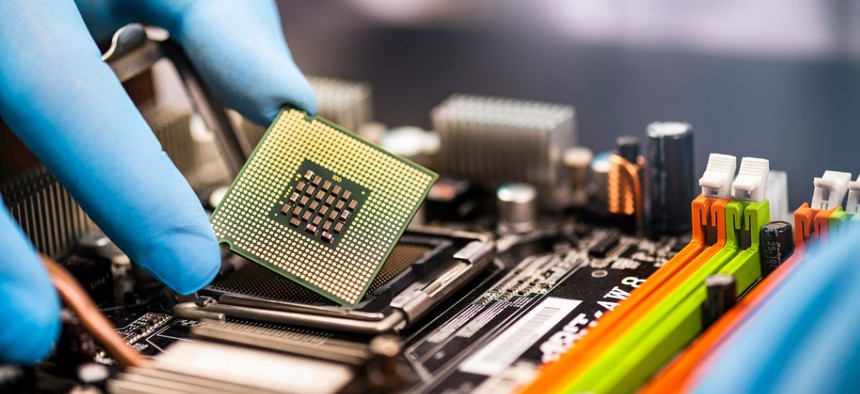Intel Community Needs Next-Gen Microelectronics for Future of AI

sefa ozel/istockphoto
IARPA wants “seedling” ideas that use a multidisciplinary approach that extends beyond traditional technological and scientific fields.
The intelligence community wants to take advantage of upcoming advances in machine learning and artificial intelligence but needs smaller, more powerful hardware to run those algorithms.
The Intelligence Advanced Research Programs Activity—the advanced research arm of the intelligence community—released a broad agency announcement in support of research into the next generation of microelectronics, including processors, semiconductors and other hardware technologies.
Researchers believe this will require a significant leap in technology and are looking for ideas from natural and social sciences, as well as art and other disciplines.
“The ability to implement AI and ML depends critically on computing models that today are limited with respect to data storage, data movement and data analysis,” the opportunity states. “Faster, more energy efficient and resilient computing requires that challenges including the physical limits on transistors, electrical interconnects, and memory elements be overcome.”
Research to date has focused on maximizing the use of existing processor chip technology. But IARPA scientists say the future will require new kinds of processors.
“To lay the foundation for long term advancements in computing technologies, a more unified approach encompassing research and development into the chemistry and physics of new materials, microelectronic devices and circuits, computing architectures and algorithm design is needed,” the notice states. “Materials scientists, chemists, and physicists, circuit designers, engineers, communications, runtime and memory architects, as well as algorithm designers and application coders must work across the historic boundaries that have separated these disciplines to achieve the next generation of highly complex systems.”
The research is in the earliest of stages, “which IARPA refers to as ‘seedlings.’”
With that in mind, the effort will be broken into two phases—A and B—with the first focused on developing initial proof-of-concept for proposals over nine months. Projects making it to Phase B will have 15 months to develop a working demo. IARPA has capped both phases at a combined total of $5 million.
Key to success will be thinking outside the traditional technological and scientific domains.
“Preference will be given to research with the ability to revolutionize hardware-software integration from material properties to hardware design, to system architecture, to software implementation,” the solicitation states. “Multidisciplinary approaches derived from life sciences, and/or inspired by artistic, anthropological, economical, and other non-traditional disciplines are welcome and encouraged.”
IARPA plans to make multiple awards for the first phase.
The effort has been divided into two topic areas for proposers to address:
Hardware, Software, Algorithm and Architecture Ecosystem
Approaches for improving the performance of AI applications in areas such as autonomous vehicles, biometrics, communications, position-navigation-timing, remote sensing, etc.
Research into optimizing the analytic performance of the hardware-software ecosystem in AI applications.
Research into tools, techniques or designs to improve the reliability and integrity of microelectronics hardware and/or hardware-software systems, to include defense or hardening supply chain, fabrication and/or computation performance against adversarial, malicious or quality control vulnerabilities.
New Science, Materials and Processing
Approaches derived from life and/or social sciences that might lead to significantly improve performance and reduce cost in the microelectronics used in AI applications.
Emerging research materials with controlled properties that can significantly improve the performance and reduce the cost of the microelectronics used in AI applications.
Novel approaches to the processing of the microelectronics—including fabrication, metrology and modeling—used in AI applications, which might lead to significant improvements in space, weight and power characteristics while reducing cost.
IARPA officials are accepting white papers—which are not required but “strongly encouraged”—by May 17. Based on those submissions, “formal proposals will then be encouraged or not encouraged,” the solicitation states, with the final deadline for proposal submission set for June 30.
“Proposals must explicitly address relevance of the technical approach to the future potential of Artificial Intelligence in the United States,” the solicitation states. “Proposals shall demonstrate that the proposed effort has the potential to make revolutionary, rather than incremental, improvements to current capabilities.”
Questions on the opportunity are due by 4 p.m. May 19.






